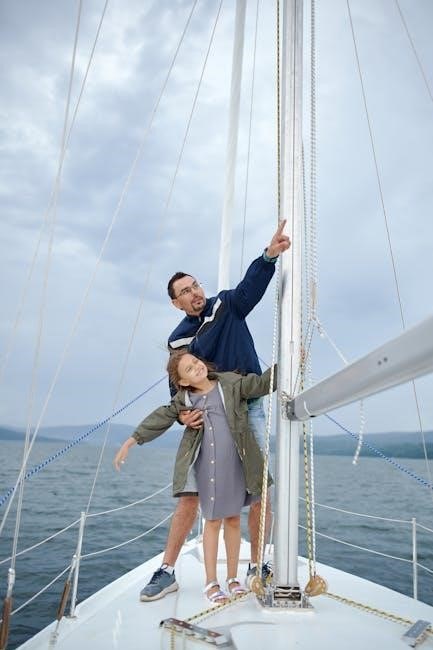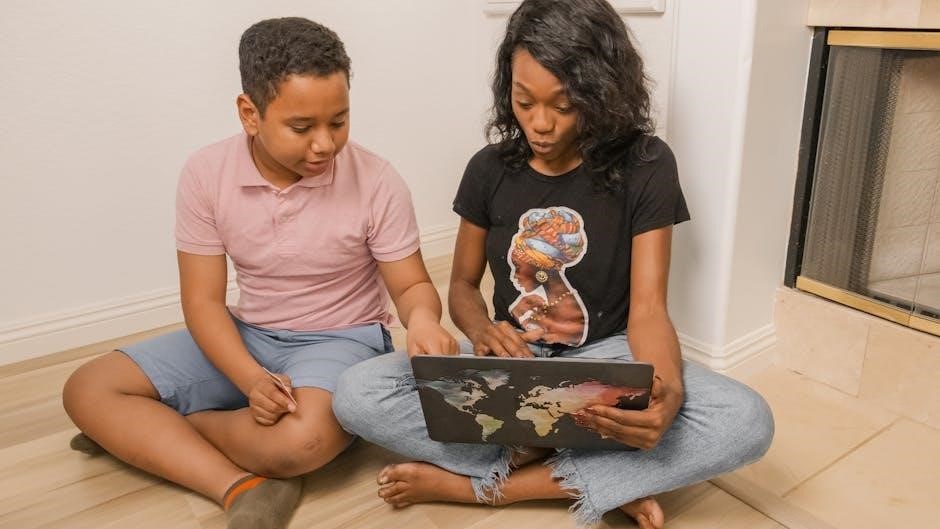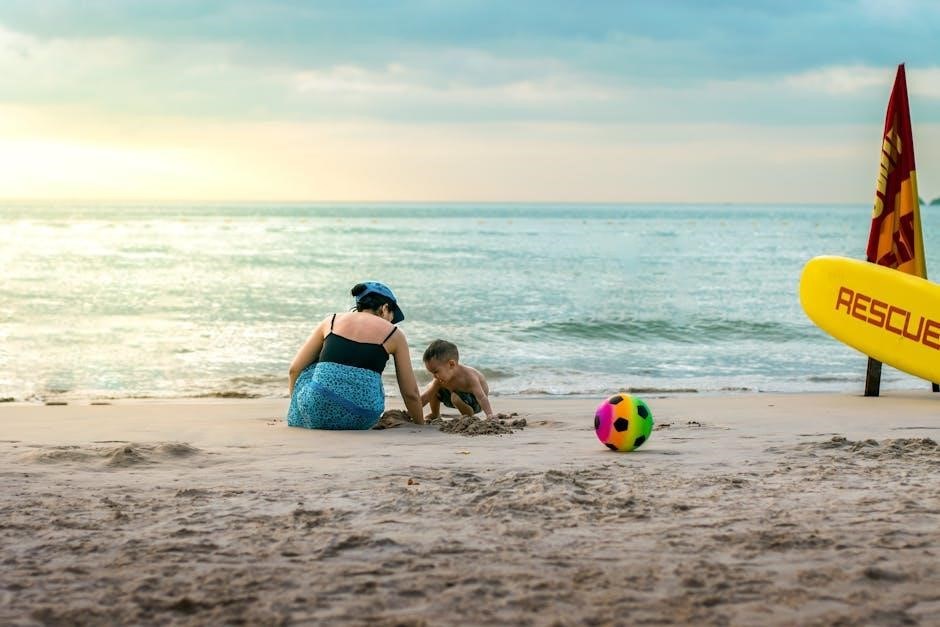
the lifeguard parents guide
Welcome to the Lifeguard Parents Guide, a comprehensive resource designed to empower parents with essential water safety knowledge. This guide covers critical topics such as recognizing distress signs, teaching children to make noise in the water, and understanding emergency procedures. By mastering these lifeguarding skills, parents can ensure a safer aquatic environment for their families, fostering confidence and awareness around water.
Understanding the Role of a Lifeguard
A lifeguard is professionally trained to supervise swimmers, prevent accidents, and respond to emergencies. Their primary duties include actively monitoring water areas, identifying distress signs, and performing rescues or first aid when needed. Lifeguards must stay alert, as their quick actions can save lives. Parents should understand that lifeguards are not babysitters but trained professionals ensuring safety. While lifeguards are essential, parental supervision remains crucial, especially for young children. By recognizing the lifeguard’s role, parents can better collaborate to create a safer environment for everyone in and around water.

Why Parents Need to Be Aware of Water Safety

Parents must prioritize water safety to protect their children from potential dangers. Accidents can occur quickly, even in shallow water, making constant vigilance essential. Drowning is a leading cause of unintentional injury among children, emphasizing the need for awareness. Parents should avoid distractions like phones while supervising kids near water. Understanding lifeguard protocols and recognizing distress signs can empower parents to act swiftly in emergencies. Teaching children to make noise while swimming and avoiding flotation aids like water wings are critical steps. By staying informed and proactive, parents can significantly reduce risks and ensure a safer aquatic environment for their families.
Water Safety Basics for Parents
Water safety begins with proactive measures. Parents should always supervise children near water, teach them to make noise while swimming, and avoid reliance on flotation devices like water wings.

Recognizing Signs of Distress in Swimmers
Recognizing signs of distress in swimmers is crucial for parents to ensure water safety. A swimmer in trouble may appear upright, with their head back and mouth open, struggling to stay afloat. They might wave their arms or call for help. Sometimes, distress can be subtle, such as quietness or sudden stillness in the water. Parents should teach children to make noise while swimming, as silence can signal trouble. Lifeguards are trained to spot these signs and act quickly. If a child becomes quiet or disappears underwater, immediate action is necessary. Always stay vigilant and know when to call for professional assistance to prevent emergencies from escalating.
Teaching Children to Make Noise While in the Water
Teaching children to make noise while in the water is a simple yet effective way to enhance safety. Encourage kids to vocalize their activities, as silence can often signal distress. Games like “Marco Polo” can make this fun and engaging. Explain that noise helps lifeguards and adults locate them quickly in case of trouble. Demonstrate how to call out clearly and wave arms if needed. Emphasize that staying loud means staying safe. This practice not only fosters awareness but also builds confidence in water environments. By making noise, children become more visible and easier to assist, reducing risks and ensuring a safer swimming experience for everyone involved.

Emergency Procedures for Parents
In water emergencies, parents should remain calm, call for help immediately, and assist in searches if trained, while ensuring their own safety and the child’s visibility.

How to Assist in a Search and Rescue Operation

When assisting in a search and rescue, parents should remain calm and immediately clear the swimming area to avoid interference. Start the search where the missing person was last seen, expanding outward systematically. Encourage others to join the effort, scanning the water and surrounding areas thoroughly. Stay visible to lifeguards and ensure the missing person’s location is communicated clearly. Avoid panicking, as this can hinder the process. If trained, parents can help spot distress signs and guide professionals. Teaching children to make noise in the water can also aid in quick location during a search. Always prioritize safety and follow lifeguard instructions.
When to Call for Help and How to Respond
Parents should call for help immediately if a swimmer is in distress or unresponsive. Stay calm and quickly assess the situation. Recognize signs of trouble, such as quietness or lack of movement in the water. Clear the area to avoid interfering with the rescue. Guide the child toward a lifeguard or shallow water if possible. Do not enter the water yourself unless necessary, as this can complicate the rescue. Shout for help loudly and follow lifeguard instructions. Teach children to call for help if they or someone else is in danger. Parents play a crucial role in ensuring timely assistance and maintaining safety.
Preventing Accidents in and Around Water
Proactive supervision, removing water hazards, and teaching children safe practices are key to preventing accidents. Avoid relying on water wings, as they can create a false sense of security.
Supervision Techniques for Parents
Active supervision is crucial for water safety. Parents should always maintain direct eye contact with their children near water, avoiding distractions like phones. Designate an adult to supervise without interruptions, ensuring immediate response to emergencies. Teach children to stay within arm’s reach in shallow water and avoid using flotation devices like water wings, which can create a false sense of security. Encourage kids to make noise while in the water, as sudden silence may signal distress. Clear the area of hazards and establish clear rules, fostering a safe environment. By staying vigilant and informed, parents can significantly reduce the risk of accidents and ensure a secure aquatic experience for their family.
Avoiding Dangers Like Water Wings

Water wings, also known as inflatable armbands, can pose significant risks to children in the water. While they may seem like a harmless flotation aid, they can create a false sense of security for both parents and kids. Water wings can slip off or deflate unexpectedly, leading to panic and potential drownings. Additionally, they hinder proper swimming technique, preventing children from learning essential water survival skills. The American Academy of Pediatrics advises against their use, recommending swim lessons and active adult supervision instead. Parents should opt for Coast Guard-approved life jackets in open water and avoid water wings altogether in pools to ensure safer aquatic experiences for their children.

Communication and Awareness
Understanding lifeguard zones and protocols is crucial for parents to ensure water safety. Stay informed about water conditions and communicate openly with lifeguards to create a safer environment for everyone.
Understanding Lifeguard Zones and Protocols
Understanding lifeguard zones and protocols is essential for parents to maximize water safety. Lifeguards divide areas into zones, each requiring specific surveillance techniques. Parents should familiarize themselves with these zones to better monitor their children. Protocols may include clearing swimming areas during emergencies and systematic search methods. By staying informed, parents can align their supervision with professional practices, enhancing overall safety. Clear communication with lifeguards and awareness of their procedures help create a coordinated approach to preventing accidents and responding effectively in critical situations. This collaboration ensures a safer environment for everyone, especially children, while they enjoy water activities.
Staying Informed About Water Conditions
Staying informed about water conditions is crucial for parents to ensure a safe aquatic environment. Check weather forecasts and warning flags at beaches or pools, as they indicate potential hazards like strong currents or rough seas. Parents should also be aware of water clarity and depth, especially in natural settings. Lifeguards often monitor these conditions, but parents should remain vigilant and communicate with them. Understanding water conditions helps parents make informed decisions about their children’s activities, preventing unexpected risks. By staying proactive and knowledgeable, parents can contribute to a safer experience for their families, aligning with lifeguard protocols and enhancing overall water safety awareness.
The Lifeguard Parents Guide equips caregivers with essential water safety knowledge, ensuring a safer aquatic environment for families. By understanding lifeguard protocols and proactive supervision, parents can prevent accidents and foster confidence in and around water, creating a secure and enjoyable experience for all.
Key Takeaways for Lifeguard Parents
As a parent, understanding water safety is crucial for protecting your family. Always supervise children near water without distractions and teach them to make noise while swimming. Recognize distress signs, such as quietness or struggling, and act quickly. Avoid using water wings, as they can be dangerous. Stay informed about lifeguard zones and protocols, and know when to call for help. By mastering these strategies, you can prevent accidents and ensure a safer aquatic environment for your children. This guide empowers you with the knowledge to be proactive and prepared, fostering confidence and awareness for a secure and enjoyable experience in and around water.